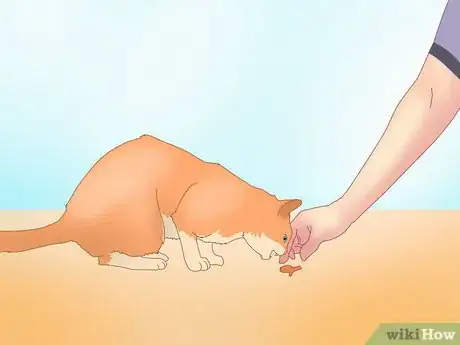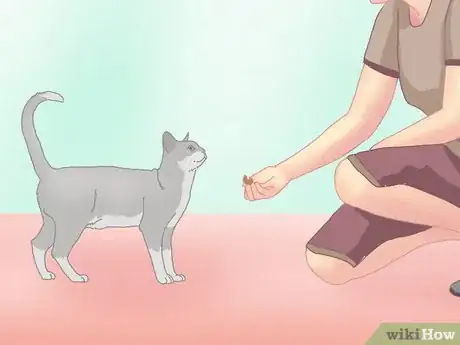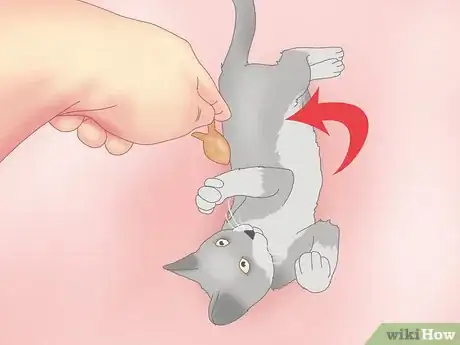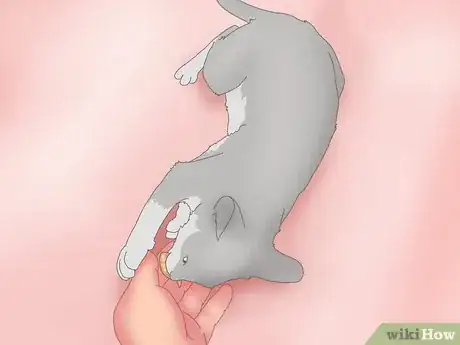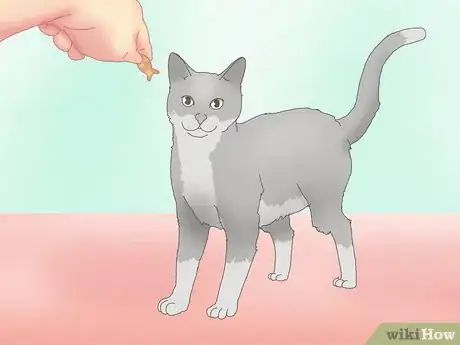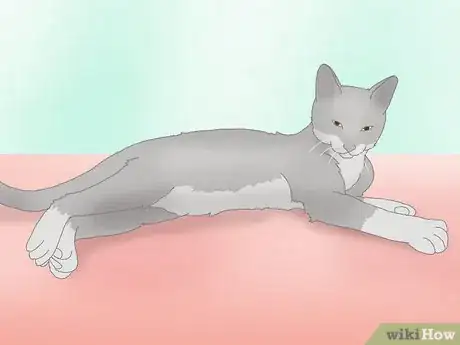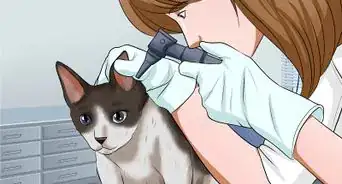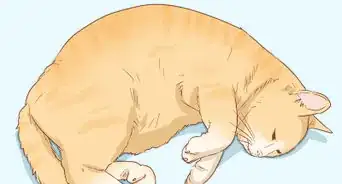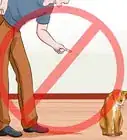This article was co-authored by Pippa Elliott, MRCVS. Dr. Elliott, BVMS, MRCVS is a veterinarian with over 30 years of experience in veterinary surgery and companion animal practice. She graduated from the University of Glasgow in 1987 with a degree in veterinary medicine and surgery. She has worked at the same animal clinic in her hometown for over 20 years.
This article has been viewed 25,079 times.
Did you know that you can train your cat? Since cats are so independent, you may not think that training cats is possible—their independence makes them less likely than dogs to work for treats and attention.[1] However, cats can be trained if given the right motivation.[2] One trick you can train your cat to do is to roll over. Getting your cat to roll over will probably take time and patience, along with plenty of tasty treats to keep her motivated.
Steps
Teaching Your Cat the ‘Sit’ Command
-
1Hold a treat in front of your cat’s nose. Getting your cat to roll over is easier when you break the trick down into small parts. The first part of the trick is to get her to sit. When you have your cat’s attention, position a treat at the level of her nose. Make sure the treat is far enough away to prevent her from easily reaching it.[3]
- The type of treat to feed her throughout the training process must be especially scrumptious to her. Examples of treats include bits of tuna and meat-flavored baby food.[4]
- If your cat is not in the room with you, you can call her to come to you. Call her using a verbal cue, such as ‘Here kitty kitty,’ and reward her immediately with a treat when she comes to you. This will may take some extra practice if your cat is not used to you calling her.
-
2Lift the treat up over her head. It is important to lift the treat slowly so that she does not stand up on her rear limbs. Lift the treat up until it is between her ears. Your cat will naturally lift her chin up to follow the treat. As her chin raises, her rear end will go towards the floor.[5]Advertisement
-
3Reward your cat when she sits. Give her the treat as soon as her rear end touches the floor. Your cat may not sit completely down the first time around, but give her a treat anyway for making the motion to sit down. With repetition—and treats with each repetition—her rear end will be completely on the floor.[6]
- Keep your training sessions (two to three per day) short—about five minutes per session—until she masters the ‘sit’ command.
-
4Replace the treat with a verbal cue or hand signal. When your cat learns to sit with the treat, you can command her to sit with only a verbal cue (‘sit’) or hand signal. To work on the verbal cue, continue to hold the treat in front of her nose, but give the verbal cue as she is sitting.[7] Reward her immediately when she sits.
- After several repetitions, give her only the verbal cue without having a treat in your hand. Reward her immediately when she sits.[8]
- The hand signal will be the same hand movement you have been making, except without the treat. Reward her immediately when she sits by following your hand signal.
- With practice, your cat will know to sit by listening to your verbal cue or watching your hand signal, rather than following a treat in front of her nose.[9]
- If you choose to give her a verbal cue, say the cue in a firm, but not raised, voice.
Teaching Your Cat to Roll Over
-
1Kneel in front of your cat. When you have commanded your cat to sit, get down on the floor with her so that you are closer to her eye level. Hold a treat in front of her nose, but not so close that she can easily swipe it out of your hand.
- The ideal times to teach your cat to roll over are when she’s sleepy or hungry. When she is sleepy, she’ll probably just let gravity do the work of lying down and rolling over. If she is hungry, she’ll probably do whatever it takes to get some tasty food.
-
2Direct your cat to swivel her head. Holding the treat close to her nose, slowly move the treat counterclockwise over her left shoulder. With her interest in the treat, she will swivel her head to follow the treat. Make sure to keep the treat far enough away that she can’t get to it.
- Move the treat in a straight line, rather than lifting it up.
-
3Move the treat towards the floor. With your cat’s attention fully fixed on the treat, continue to move the treat over her left shoulder and then towards the floor on her left side. Say ‘roll over’ as you are moving the treat to the floor. As her head continues to swivel to follow the treat, she will shift her weight to her left side and eventually lay down on the floor.
-
4Reward your cat when she rolls over to one side. When your cat is laying on the floor and reaching for the treat with her paws, she will naturally roll over. When you see her roll over, reward her with a treat immediately.
- In her attempt to paw at the treat, her belly will automatically go up. When her belly goes up, she will roll over.
- Be mindful that your cat may roll over quickly when she’s down on the floor. Keep a close eye on her movements so that you reward her immediately when she rolls over.[10]
-
5Entice your cat to come back up. With a new treat in your hand, hold it front of her nose when she is rolled over onto her left side. Slowly move the treat counterclockwise until she is laying on the floor on all fours (‘four-on-the-floor’) or sitting up.
- Reward her immediately when she is in the ‘four-on-the-floor’ position or sitting up.
-
6Practice daily. Your cat may be a quick learner and master the trick in a few days. Or, she may need up to a few weeks until she can roll over with ease at your command. No matter how long it takes, keep your daily practice sessions short (up to 5 minutes). [11]
- Limit your training to a few sessions per day. If you practice too much, your cat may actually get bored and simply walk away from the practice session.
- Once you see that she has mastered the trick with treats, work on commanding her to roll over without giving her treats.
Expert Q&A
-
QuestionHow do you teach your cat to play dead?
 Pippa Elliott, MRCVSDr. Elliott, BVMS, MRCVS is a veterinarian with over 30 years of experience in veterinary surgery and companion animal practice. She graduated from the University of Glasgow in 1987 with a degree in veterinary medicine and surgery. She has worked at the same animal clinic in her hometown for over 20 years.
Pippa Elliott, MRCVSDr. Elliott, BVMS, MRCVS is a veterinarian with over 30 years of experience in veterinary surgery and companion animal practice. She graduated from the University of Glasgow in 1987 with a degree in veterinary medicine and surgery. She has worked at the same animal clinic in her hometown for over 20 years.
Veterinarian Use a tasty treat to lure the cat into a lying position. Say "Bang" and then reward the cat with the treat.
Use a tasty treat to lure the cat into a lying position. Say "Bang" and then reward the cat with the treat. -
QuestionHow do you teach a cat to sit?
 Pippa Elliott, MRCVSDr. Elliott, BVMS, MRCVS is a veterinarian with over 30 years of experience in veterinary surgery and companion animal practice. She graduated from the University of Glasgow in 1987 with a degree in veterinary medicine and surgery. She has worked at the same animal clinic in her hometown for over 20 years.
Pippa Elliott, MRCVSDr. Elliott, BVMS, MRCVS is a veterinarian with over 30 years of experience in veterinary surgery and companion animal practice. She graduated from the University of Glasgow in 1987 with a degree in veterinary medicine and surgery. She has worked at the same animal clinic in her hometown for over 20 years.
Veterinarian Find a treat the cat absolutely adores. Hold the treat in front of the cat's nose and slowly move your hand in an arc over and behind the cat's head. As the cat follows the treat, their butt will sink to the ground. At the same time, say "Sit" and reward the cat with the treat.
Find a treat the cat absolutely adores. Hold the treat in front of the cat's nose and slowly move your hand in an arc over and behind the cat's head. As the cat follows the treat, their butt will sink to the ground. At the same time, say "Sit" and reward the cat with the treat.
References
- ↑ https://www.aspca.org/pet-care/virtual-pet-behaviorist/cat-behavior/training-your-cat
- ↑ https://www.aspca.org/pet-care/virtual-pet-behaviorist/cat-behavior/teaching-your-cat-come-when-called
- ↑ https://www.aspca.org/pet-care/virtual-pet-behaviorist/cat-behavior/training-your-cat
- ↑ https://www.aspca.org/pet-care/virtual-pet-behaviorist/cat-behavior/training-your-cat
- ↑ https://www.aspca.org/pet-care/virtual-pet-behaviorist/cat-behavior/training-your-cat
- ↑ https://www.aspca.org/pet-care/virtual-pet-behaviorist/cat-behavior/training-your-cat
- ↑ http://www.vetstreet.com/our-pet-experts/how-to-train-your-cat-to-sit
- ↑ http://www.vetstreet.com/our-pet-experts/how-to-train-your-cat-to-sit
- ↑ http://www.vetstreet.com/our-pet-experts/how-to-train-your-cat-to-sit
- ↑ spcacincinnati.org/docs/education/cats/Cat.TeachToRollover.2.9.15.pdf
- ↑ http://meowaum.com/how-to-teach-your-cat-to-lay-down-and-roll-over-on-command/
- ↑ https://www.vet.cornell.edu/departments-centers-and-institutes/cornell-feline-health-center/health-information/feline-health-topics/feeding-your-cat
About This Article
To get a cat to roll over, start by holding a treat close to its nose and then slowly moving it counterclockwise over its shoulder. As you're doing this, keep the treat just enough away that it can’t swipe it out of your hand. Then, move the treat towards the floor and say “roll over." Your cat will naturally roll over when it’s laying on the floor and reaching for the treat. When it does, give it the treat right away to reward it. For more tips from our Veterinary co-author, including how to get your cat to come back up on all fours after rolling over, read on!


